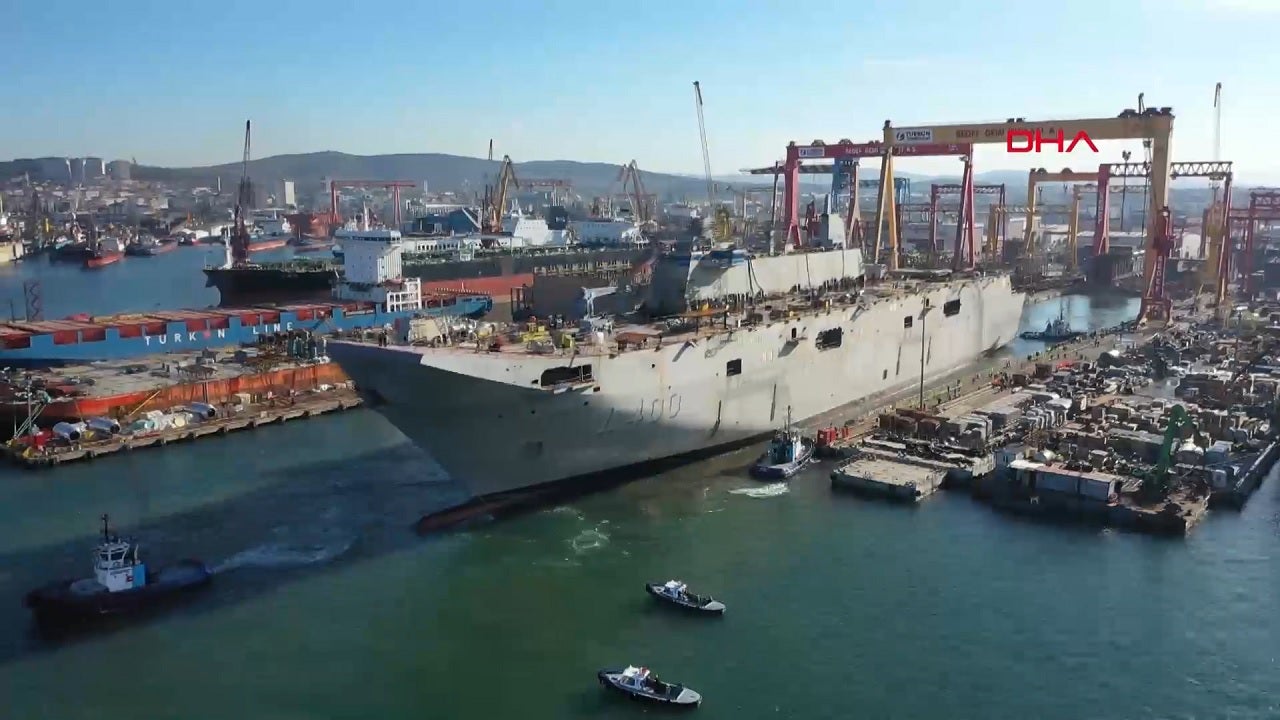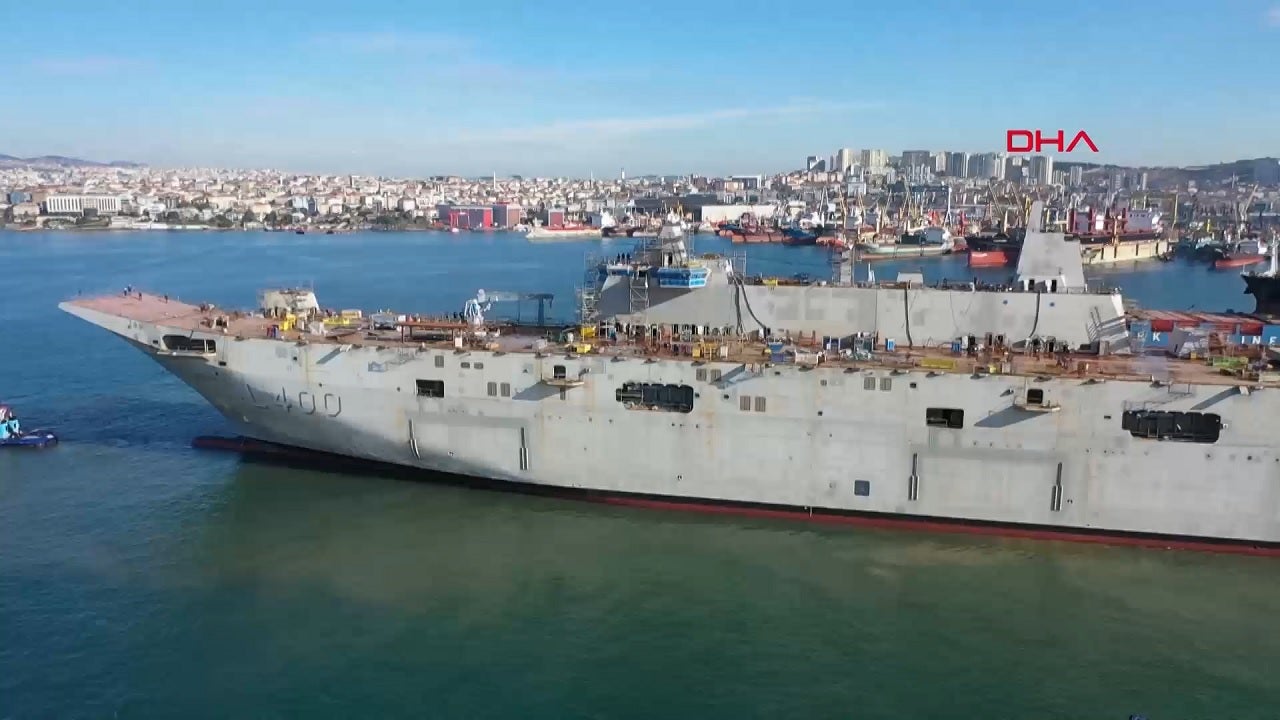TCG Anadolu is a multi-purpose amphibious assault ship being developed by Sedef Shipyard, in collaboration with Navantia, for the Turkish Navy.
The new assault ship can be configured as a mini aircraft carrier and is expected to be used in the Aegean, Black Sea and Mediterranean Sea regions, as well as the Indian and Atlantic Oceans.
Construction of the Anadolu ship began in April 2016 and the vessel was moved to Sedef Shipyard’s pier in Tuzla to prepare for harbour acceptance tests in February 2021, following the integration of the main propulsion system. The new assault ship is expected to enter service in 2022.
Set to become Turkey’s first native and national aircraft carrier, TCG Anadolu will improve the operational capability of the country’s naval forces.
TCG Anadolu design and features
TCG Anadolu (L-408) is believed to be based on the same configuration as that of the SPS Juan Carlos I (L-61), a multipurpose amphibious assault ship aircraft carrier in the Spanish Navy. Considered the admiral ship of the Turkish Navy, TCG Anadolu measures 232m long and 32m wide. The 58m-high vessel will have a 1,400m² lower garage under the hangar to accommodate heavy loads.
Named after the peninsula of Anatolia in Turkey, the ship will have a 1,165m² floodable well dock, a 1,800m² light vehicle deck and 900m² of hangar space. Furthermore, it will be equipped with a 5,440m² fully-equipped flight deck with six landing spots and a ski-jump ramp to the front. The landing helicopter dock (LHD) will be able to support long-endurance and long-distance military combat, or humanitarian relief operations.
TCG Anadolu will be the largest naval vessel in the Turkish Armed Forces’ inventory. With a full load displacement of 27,436t, the vessel will have a crew of 261 persons, consisting of 30 officers, 59 seamen and 49 non-commissioned officers.
The ship will have provision for a hospital, which could be equipped with at least 30 beds, an operation theatre, dental treatment units, x-ray devices, emergency and intensive care units, and sterilisation rooms. TCG Anadolu will serve as a hospital vessel during humanitarian operations.
Sensors on board TCG Anadolu
TCG Anadolu will use Armelsan’s ARAS-2023 diver detection sonar system. The radar system will include two navigation radars, a SMART-S naval 3-D search radar, two Alper low probability of intercept (LPI) radars as well as a precision approach and aerial vehicle detection and control radar.
The Leonardo SPN-720 Precision Approach Radar will assist aircraft during landing in all weather conditions.
The ship will be installed with a Turkish combat management system, the GENESIS-ADVENT.
The amphibious assault ship will also feature electronic warfare systems, decoy launching systems, a SeaEye-AHTAPOT electro-optical reconnaissance and surveillance system, as well as a PIRI infrared search and track system.
Communication systems
The communication systems on board the vessel will include an internal naval communication system, external naval communication system, data link system, X-band, Ku-band, UHF satellite communication system and identification friend or foe (IFF) system.
Aircraft carried by TCG Anadolu
TCG Anadolu will have the capacity to carry six F35-B aircraft, two Seahawk general-purpose helicopters, four ATAK helicopters, eight medium-range transport helicopters and two unmanned aerial vehicles (UAVs).
The assault ship will be able to support the launch and recovery of unmanned combat aerial vehicles (UCAVs), such as the TB-3 Bayraktar drone.
The flight deck will allow day-and-night operations using the heaviest Nato helicopters and Osprey aircraft.
The ability to carry tactical aircraft capable of short-distance take-off and vertical landing, such as the F-35B, will enable Turkey to become a global power.
The ship can carry an amphibious troop, as well as the required battle and support vehicles, to conflict areas. Furthermore, it is designed to undertake landing operations with the landing craft in its dock.
Weapon systems
The aircraft carrier can be armed with five Aselsan 25mm STOP remote weapon systems, two Raytheon Phalanx close-in weapon systems (CIWS) and the Rolling Airframe Missile (RAM) surface-to-air missile system. It is also expected to be fitted with Hizir torpedo countermeasures systems.
Propulsion of Turkish amphibious assault ship
The LHD’s electric propulsion system will feature five 16V32/40 8,000kW Man diesel generators, two 11MW Siemens eSIPOD propulsion drive systems and two bow thrusters.
The ship is expected to achieve a maximum speed of 21.5k in light aircraft carrier configuration and 29k in LHD configuration. With an economical speed of 16k, TCG Anadolu will be able to achieve a maximum range of 9,000 nautical miles.
Contractors involved
The Turkish Navy awarded the landing platform dock or landing helicopter dock (LPD or LHD) tender to a consortium led by Sedef Shipyard and Spanish shipbuilding firm Navantia in 2015.
Aselsan, a Turkish military products manufacturer, is responsible for the integration, design, production, testing and logistic support of radars, sensors and other equipment for the amphibious warship.
Aselsan was also contracted to procure the ship’s entire weapon system, including the integration of the combat management system, in collaboration with Turkish software firm Havelsan.
Armelsan, a sonar systems supplier based in Turkey, was contracted to provide the ARAS-2023 diver detection sonar, while engineering company Stopson Italiana was selected to supply inlet duct and engine exhaust silencers to reduce the noise generated by the propulsion system.










